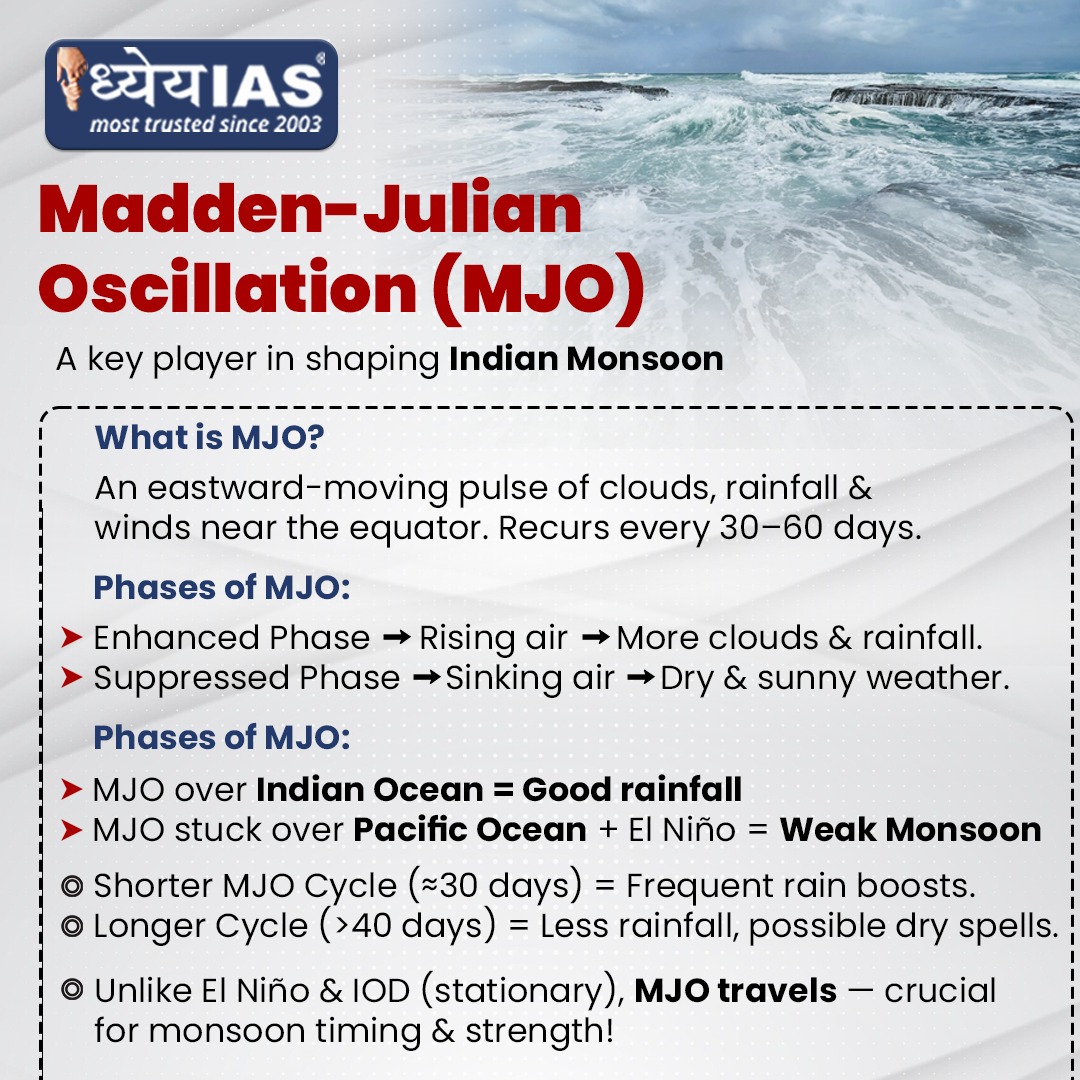Context:
The southwest monsoon arrived in Kerala on May 24, 2024, eight days earlier than usual. It reached Mumbai by May 26, the earliest ever recorded. According to the India Meteorological Department (IMD), this early onset was influenced by several weather factors — with the Madden-Julian Oscillation (MJO) playing a key role.
About Madden-Julian Oscillation:
The Madden-Julian Oscillation is a system of changing winds, clouds, and rainfall that moves eastward along the equator. It was discovered in 1971 by scientists Roland Madden and Paul Julian.
The MJO travels around the world in 30 to 60 days, sometimes taking up to 90 days. It moves at a speed of 4 to 8 meters per second.
The MJO has two main phases:
· Active Phase: More clouds, rainfall, and storms.
· Suppressed Phase: Drier weather with less rainfall.
These phases keep alternating and impact tropical regions, especially the area between 30° North and 30° South, which includes India.
Significance of MJO for the Monsoon:
The MJO affects rainfall patterns and storm formation. During its active phase over the Indian Ocean, it can:
· Trigger early or strong monsoon onset.
· Increase cyclonic activity.
· Enhance rainfall.
For example, in June 2015, the MJO brought nearly 20 days of good rainfall across India.
In May 2024, the MJO became active over the Indian Ocean. By May 22, 2024, it had entered Phase 4 — a stage known to increase rainfall over India. Its amplitude was greater than 1, which indicates strong activity. This helped form pre-monsoon storms and pushed the monsoon forward faster than usual.
Interaction with El Niño Conditions:
The MJO’s relationship with El Niño — the abnormal warming of sea-surface waters in the equatorial Pacific — is complex. Strong MJO activity often co-occurs with El Niño years, although this is not a consistent or causal relationship. Interestingly, strong El Niño years are usually associated with poor monsoon performance over India due to weakened cross-equatorial flow and suppressed convection.
Despite this general trend, the presence of an active MJO in an El Niño year (as in 2024) can temporarily offset El Niño’s suppressive influence, particularly during the early stages of the monsoon.
Implications for Forecasting and Policy
The 2024 experience underscores the growing importance of intra-seasonal oscillations like the MJO in shaping monsoon dynamics.
· For India, where agricultural productivity, water resource planning, and disaster preparedness are all heavily monsoon-dependent, improved monitoring and prediction of the MJO can enhance seasonal and sub-seasonal forecasts.
· An active MJO in the Indian Ocean phase can substantially advance monsoon onset.
· Real-time tracking of MJO phase and amplitude is critical for early warning systems.
· Incorporating MJO signals into models can improve the spatial and temporal accuracy of rainfall forecasts.
Conclusion
The early monsoon in 2024 shows how powerful the MJO can be. It acted as a counter to the usual dry conditions seen in El Niño years. Better understanding of such weather systems can help India prepare for both good and bad monsoon seasons.







